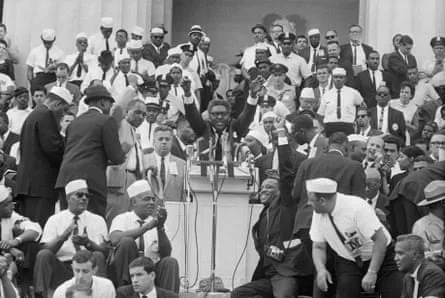At only about 200 pages, Bayard Rustin: A Legacy of Protest and Politics is a pleasure to read, 23 contributors giving their take on the great civil rights advocate. Edited by the scholar Michael G Long, it is a must for those who want to better understand the complexity of a Black hero who was also an imperfect man.
Rustin, the Obama-produced feature film airing on Netflix, is the most prominent example an industry of emergent Rustin scholarship. A spate of Rustin essays, Rustin books and Rustin docuseries round out the genre. They commemorate the 60th anniversary of Rustin’s foremost achievement: the March on Washington of 1963, a great protest for African American civil and economic rights.
The Civil Rights Acts of 1964 was among its results. Long explains how, with this peaceful demonstration as a template, “millions of protesters … would similarly march on Washington for women’s rights, labor rights, LGBTQ+ rights, and so much more. No protest in US history has been more influential and consequential.”
What is it that makes the book Long has edited so special? It is its economy. Without spending a long time, from several angles you get a good picture of who Rustin was.
I never met Rustin, but I did meet and was befriended by Walter Naegle. Legally adopted by Rustin so no one could contest his eventual bequest, in any real sense Naegle is Rustin’s widower. They met in 1977 and were together for the final decade of Rustin’s life.
“He had a wonderful shock of white hair,” Naegle writes. “I guess he was of my parents’ generation, but we looked at each other and lightning struck.”
When he moved to New York in the late 1930s, Rustin joined the 15th Street Meeting of the Religious Society of Friends. Any source one consults emphasizes how imperative his Quaker upbringing was. He was reared not by his unmarried teenaged mother but by his maternal grandmother. Her beliefs inspired his highly moral sense of ethics.
Naegle writes: “Bayard always credited Julia [Edith Davis Rustin] with having the most profound impact on his early development. She attended West Chester, Pennsylvania’s Friends School. Her education stressed ‘human family oneness, equality, integrity, community, and peace through nonviolence’. It was this Quaker nonviolence, enhanced by Gandhi’s version, that Rustin studied in India, which he taught to Rev Martin Luther King. This was how King’s movement changed history.”
I always assumed that as a boy Rustin followed a trajectory similar to that followed by his grandmother. I envisioned him interacting with white Quakers with ease. But Naegle relates something else. When she married, Rustin’s grandmother joined her husband’s African Methodist Episcopal church. Notwithstanding the strong Quaker identity they shared, neither she nor Bayard were welcome to attend the West Chester Friends Meeting. Far from the “Peaceable Kingdom” I pictured, Rustin experienced a grimmer youth. Replete with racial segregation, there was even a local chapter of the Ku Klux Klan.
All the same, Rustin’s Quaker beliefs led him to pacifism. A conscientious objector during the second world war, he received a two-year prison term. He sought to serve fellow inmates, organizing them to protest for better conditions. Earlier, at Wilberforce University, Rustin had been expelled for organizing students – and for being gay. Jail authorities didn’t hesitate to use his sexuality against him. To be queer was to be perceived as deviant and depraved. Confessing his sexuality to his grandmother, he had only been admonished: “Never associate with anyone who has less to lose than you do.” In prison it was a different matter. Black or white, on learning about Rustin’s sexuality, most prisoners wanted nothing to do with him.

Being deemed deviant and illegal haunted Rustin’s life well after his release in 1946. One friend stood by him steadfastly. A fellow socialist, Asa Philip Randolph, had established America’s first Black labor union, the International Brotherhood of Sleeping Car Porters. Rustin’s capabilities as an organizer, orator and agitator impressed Randolph early. Their first big protest, a 1941 march on the capital, was canceled after Franklin Roosevelt desegregated war production contracts.
after newsletter promotion
By 1960, the worst sex scandal of all threatened to break into public. Envious, Harlem’s Black congressional representative demanded that King cancel a demonstration outside the Democratic National Convention. In his contribution to A Legacy of Protest and Politics, John d’Emilio tells us how the Rev Adam Clayton Powell Jr promised: “If King did not call off the protests … Powell would [claim] that King and Rustin were having a sexual affair. King immediately canceled the demonstrations.”
Three years later, before the March on Washington, Senator Strom Thurmond of South Carolina attempted to kill it by reading an old Rustin arrest into the record. It backfired. People laughed. Thanks to Randolph, Rustin was back. Some 250,000 people were safely transported to the Lincoln Memorial. The sound system worked and so did the portable toilets. Despite an overwhelming police presence, no one was shot.
Rustin was multifaceted but fallible. In this insightful book, several observers contend that no one else could have done as well. Others are impressed by how Rustin combated oppression and injustice around the world. He helped normalize radical solutions to enduring problems like unemployment and inequality. His endorsement of a two-state solution in the Middle East was tact itself. However, chided by Malcolm X, Rustin’s nonviolent stance evolved. Addressing the Watts riots, he noted somberly: “If negro rioting is to be avoided in the future, it will be because negroes are enabled to get out of the vicious cycle of frustration that breeds aggression; because this country proves that it is capable of creating a new economic way of life without unemployment, without slums, without poverty.”
This book makes clear that Bayard Rustin, a man for his time, is a man for our time too.
-
Bayard Rustin: A Legacy of Protest and Politics is published in the US by New York University Press


